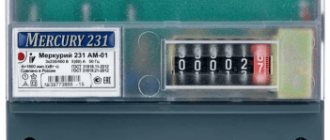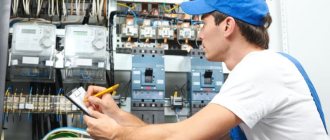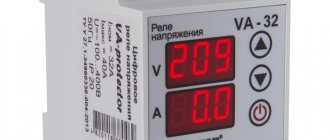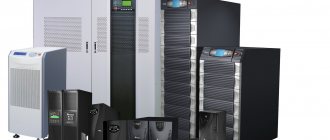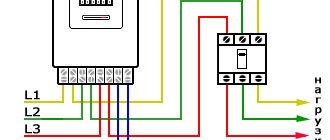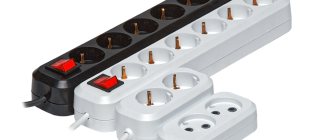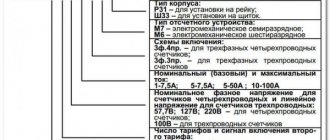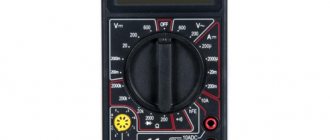- August 23, 2020
- Tools and equipment
- Daria Mingilevich
The concept of three-phase connection is not only found in industrial halls. We are increasingly encountering this in new buildings and even in old houses, if the electrical installation allows. This makes it possible to use devices with higher energy requirements, and a three-phase electricity meter becomes necessary.
In today's article we will look at how to choose a three-phase meter for your own home, apartment or other premises. We will also get acquainted with several options for popular counters.
In homes with high energy consumption
The device is also used in households. There are more and more electrical devices in our homes, which usually have a fairly high demand for electricity. This type of device is suitable if our electrical installation is adapted to this type of connection and we want to simultaneously use:
- electric heating;
- induction cooker;
- air conditioning system;
- Lots of small household appliances and electronics.
For induction cookers, it is recommended to use a three-phase network and, accordingly, a three-phase electricity meter.
Differences from a single-phase electric meter
Rice.
2. Difference between a three-phase and a single-phase electricity meter Despite the identity of the processes in both types of electricity meters, there are a number of differences between them. A three-phase electricity meter differs from single-phase models in the following factors. The single-phase electric meter is designed for installation in two-wire circuits with a rated voltage of 230V. While three-phase electricity meters are used in three and four-wire circuits with a rated voltage of 230/400V.
Single-phase models are characterized by relatively low power of the connected equipment - about 10 kW. In comparison with three-phase electricity meters, the power of which is practically unlimited, but the connection method will differ (direct, indirect or semi-indirect).
How does a three-phase meter work?
First of all, let's find out the principle of operation and which three-phase meter to choose for a private home.
The operating principle of a three-phase energy meter is almost the same as for models adapted to 1 phase. The device takes measurements for each cable separately, although we can see the total on the screen. These are really three 1-phase meters integrated in one housing. Most often we come across electronic devices that have special integrated circuits. When exposed to current flow, they generate measurable pulses, which we interpret as kWh consumed.
Types of three-phase devices
Meters can be divided into two types: single-tariff and multi-tariff. Some models have a division between daytime and evening rates.
A small microprocessor is responsible for locating tariffs and storing information in the device’s memory. Simply put, you can view the meter data for any convenient numbers.
Analog induction energy meters
The operating principle of such meters is similar to the single-phase device model.
Connection diagram for 3 phase meter
Electrical energy passing through the induction coil forms an electromagnetic field that acts on the iron disk. So he starts moving.
Is unbalanced meter load a problem?
We often wonder how the asymmetric load on the wires affects the accuracy of the readings, and also which three-phase meter to choose for a private home. Let's imagine a situation in which electric heating is connected to one phase, an induction cooker is connected to another, and the third phase is responsible for the remaining small household appliances. In summer we do not heat the room, so one phase is completely unloaded. Does this affect the measurements taken? A very similar problem is the operation of a device with only one or two phases connected.
Fortunately, electronic electricity meters are excellent at dealing with such problems. We don't need to have a symmetrical load or even all phases connected to the device. This is due to the meter design. Each phase is measured completely separately, and the zero measurement is simply added to the non-zero value and displayed on the LCD screen.
Nuances of operation
During operation, it is important to ensure uniform loading of phase conductors in the lines to avoid distortion. Therefore, the distribution of single-phase electrical appliances for a three-phase meter should be calculated in advance.
Please note that during operation, all electronic models are extremely sensitive to voltage drops and excess current load. Therefore, such a three-phase meter must be protected from damage by short-circuit currents, for which protective equipment is installed on the line side and on the side of connected electrical devices.
It is important to prevent exposure of the electricity meter to adverse atmospheric, weather and other factors, as this can lead to its failure or other malfunctions.
Is the phase connection order important?
The instructions included with the electronic electricity meter clearly indicate that the manufacturers recommend connecting the phases in a specific order. This has to do with diagrams. However, if it turns out that they are not connected correctly, you must call an authorized power plant employee if the meter belongs to him. In the case of a submeter, a qualified electrician must be called.
If you have a modern electricity meter, the LCD will most likely show a message indicating an incorrect phase connection. Some models will indicate this situation by flashing or turning on an LED. In this case, the cables must be swapped so that the device can work. Depending on whose property the meter is, you must call the power company or an electrician with the appropriate permit.
General information
A three-phase electrical network simplifies the creation and operation of electrical machines, such as, for example, the asynchronous motor, which has become the basis of many industrial machines. All residential buildings are connected to a three-phase alternating voltage network , and the owners of most private buildings use 380 volts to electrify their properties.
The compatibility of an industrial three-phase electrical network with a household one is associated with several options for consumer connection schemes. Thanks to this, consumers can use either 220 volts or 380 volts and distribute the load between the phases.
As a rule, a three-phase electrical network is four-wire - three linear wires and one zero. In linear wires, the voltage phase is consistently shifted by 1/3 of the period. To distinguish them from each other, they are designated by the letters A, B and C or L 1, L 2, L 3 and have different standardized color markings. So, in Russia, Kazakhstan, Ukraine and China, phase A is yellow, phase B is green, C is red, zero is blue or cyan.
In addition to the four current-carrying wires of a three-phase network, there is a fifth one - grounding, which protects consumers and people from emergency operation of electrical appliances.
When connecting any devices to a three-phase power supply, the phase sequence must be observed. You can navigate by the color marking of the conductors, but for control you need to use a special device - a phase indicator.
Problem with old meters
Problems with measuring electricity consumption may arise if you have an old-style three-phase electricity meter (inductive). In such situations, a countdown is often observed. For proper operation it is necessary to change the phase connection. You also need to understand which three-phase meter to choose for a private home if it is replaced.
When it happens that when you start one of your household electrical appliances, your fuses turn off, this means that the electrical installation is overloaded. This is for your own safety. To be able to use any number of devices without any obstacles, you must ask the energy company that supports you to check the connection capacity and increase it accordingly.
If you only have one phase, it's worth finding out whether the specifications allow you to change the connection to three-phase. You can also easily find out if you are using it anymore. Just check if the meter in your apartment is three-phase.
What are the advantages and disadvantages of three-phase electricity meters?
Like any equipment, a three-phase meter has both certain advantages and disadvantages. Among the disadvantages of such equipment:
- when connecting a three-phase electricity meter in an apartment, if possible, permission from the energy sales company will be required;
- increased risk of emergency situations due to an increase in the number of current-carrying wires;
- the need to increase the size of the distribution board.
Sometimes there may not be enough space for installation, you have to change the shield PHOTO:
But all these disadvantages are more than offset by the advantages that a three-phase network has. Let us note the following:
- it becomes possible to connect more powerful equipment;
- the conductors of the input cable will have a smaller cross-section;
- the load can be evenly distributed across different phases;
- the home network is not completely disconnected when one of the phases at a substation or line breaks.
Review of popular models for a private home
A 3-phase electric meter is more expensive than similar single-phase devices. However, it gives you much more options. Therefore, there is a huge problem when it comes to the question of which three-phase meter to choose for a private home. We present popular models that you can buy alone or get from your electricity supply company.
Let's look at popular models of three-phase meters.
Zemel 16EC3gw
Basic model that works well in a four-wire network. This is an excellent three-phase electricity meter for a private home. Its features:
- multi-zone active energy measurement;
- time zone control;
- indication of external magnetic field;
- alarm failure.
This model is suitable for use as an electric meter if, for example, two families live in the same house. As you can see, you don’t need to make a lot of effort to choose a three-phase meter for a private home.
INCOTEX Mercury 230 AM-02 10(100) A
The three-phase single-tariff electricity meter Mercury 230 AM accounts for unidirectional electricity in 3-phase alternating current circuits directly or through measuring transformers in a digital way. It is equipped with a mechanical display and is designed for operation in dry indoor areas (protection level IP20).
Operating temperature range from -40 to +55. The device is mounted on the surface using screws. In this meter model, the numbers on the display indicate kilowatt hours. The calibration interval, like many meters, is 10 years. The warranty period is 3 years. The average operating time is 140,000 hours.
Advantages:
- simplicity of design and installation;
- equipped with a reverse operation stopper;
- protection against magnetic fields;
- housing made of durable plastic.
Flaws:
- at low voltage in the network, failures in electricity calculations are possible;
- lack of data transfer interface.
Bemko A30-EM3-L
Today, finding a meter on the domestic market is a big problem. When deciding which electricity meter to choose for a private home, it is good to choose the Bemko A30-EM3-L.
This is a slightly more expensive model, equipped with an LED display and three diodes indicating current measurement in all three phases. An accuracy of 0.01 kWh allows accurate measurement of energy consumption. The device operates on a four-wire network. The maximum load is up to 100 A. So this is one of the acceptable options for three-phase meters for a private home.
PAC2200
The PAC2200 is a good option. This is a smart energy meter from the well-known Siemens company, which is used both in infrastructure and in industry. The device measures all basic electrical quantities: voltages, currents, power and energy. The modular design and DIN rail mountability allow it to be used in areas where space is limited, such as drain boxes. The built-in Ethernet or RS485 communication port allows flexible adaptation of the network structure to the user's needs.
Advantages:
- Compact design - DIN rail mounting allows the meter to be installed in areas with limited space, such as drain boxes.
- Convenient connection diagram for a three-phase meter in a private house.
- Built-in Communications - The PAC2200 energy meter has a built-in Ethernet (Modbus TCP/IP) or RS485 (Modbus RTU) communications port. This functionality allows the device to be integrated with superior systems such as Powerconfig or Powermanager.
- Embedded Web Server - The PAC2200 with Ethernet connectivity allows you to remotely view measured parameters from each network access point using a standard web browser. This feature allows you to view both current and historical data (for example, energy consumption on certain days of the week) without the need for additional software. You can also view parameters measured on mobile devices, phone or tablet.
- Built-in memory - the PAC2200 energy meter archives energy measurement data. Thanks to this, the user can easily check the energy consumption measured by the meter, for example on individual days of the week. Using this functionality is an alternative to a full energy management system.
- Integration with EMS Powermanager - SENTRON Powermanager energy management system has built-in libraries for working with PAC2200 meters, making the integration of meters in this application very simple and can be limited to setting the IP address of the device.
Electricity meters. Part 1. Induction and electronic
In the modern world, you can no longer do without these devices.
After all, everyone in their house has electrical wiring, therefore, there must be an electric meter. But here's the problem. As soon as the time comes to replace or install a meter, we go to the store and are bombarded with a barrage of choices. We start to get lost and end up choosing the wrong thing.
To prevent this from happening, let's figure out what types of counters there are and which one is right for you. Today there are two main types of meters: induction (mechanical) and electronic.
Induction (mechanical) electricity meters
Fig.1. Induction single-phase electric meter
Counters with a rotating disk are familiar to almost everyone. These are the ones that have a rotating wheel behind the transparent panel. Surely many have observed the speed of its rotation more than once - the higher the speed, the greater the energy consumption. And the counter readings are indicated by numbers on special reels.
The operating principle of such counters is as follows. The electric meter has 2 coils (Fig. 2 - 1 and 4 indexes) - a voltage coil (serves as an alternating current limiter, a barrier to interference, etc., creates a magnetic flux commensurate with the voltage) and a current coil (creates an alternating magnetic flux commensurate with the current ).
Fig.2. Operating principle of an induction electric meter
The magnetic fluxes created by the coils penetrate through the aluminum disk (Fig. 2, pointer 5). In this case, the flows created by the current coil penetrate the disk several times due to its U-shape. As a result, electromechanical forces appear, which rotate the disk.
Next, the disk axis interacts with the counting mechanism in the form of a worm (gear-screw) transmission (Fig. 3), which transmits the necessary signals and information to the digital reels. The higher the disk torque, the higher the power of the supplied signal (the torque is equal to the power of the network), and therefore the higher the power consumption.
Fig.3. Worm-gear
note
When the power of the supplied electromagnetic signal decreases, the permanent braking magnet comes into action (Fig. 2, pointer 3). It evens out fluctuations in the disk rotation frequency due to interaction with vortex flows. The magnet creates an electromechanical force opposite to the torsion of the disk. This causes the drive to slow down or stop altogether.
This group of meters is the cheapest and simplest. Induction electricity meters were widely used in Soviet times (and to this day, most apartments have just such devices installed).
But gradually they are being replaced by electronic meters due to a number of disadvantages of induction devices.
For example, an induction electric meter cannot take readings automatically, and there is often an error in the readings.
Advantages and disadvantages of induction meters
Advantages
- Reliable to use
- Long-term service life of the meter
- Independence from power fluctuations
- Cheaper than electronic ones
Flaws
- The accuracy class is quite low - 2.0; 2.5
- There is practically no protection against theft of electrical energy
- High self-current consumption
- At low loads the error increases (the lower the accuracy class, the greater the error)
- When metering several types of electricity (active and reactive), there is a need to use several energy metering devices
- Energy metering is carried out in one direction
- Large dimensions of devices
Electronic electricity meters
Fig.4. Electronic electricity meter
These devices are somewhat more expensive than induction ones, but today they are the most profitable and priority meters to use. They have a higher accuracy class and allow multiple tariffs to be taken into account.
Electronic electricity meters work by converting the analog input signal from the current sensor into a digital code equal to the power consumption. This code is sent to a special microcontroller to be decrypted. After that, the amount of electricity consumed is displayed on the display (or digital drum).
The most important component of these counters is the microcontroller. It is he who analyzes the signal and calculates the amount of electricity consumed. It also transmits information to output, electromechanical devices and display.
Fig.5. Operating principle of an electronic electricity meter
The device itself consists of a housing, a current transformer, a signal converter and a tariff module. If we look at it in more detail, the meter also includes:
- LCD (or digital drum)
- secondary power supply (converts AC voltage)
- microcontroller (calculates input pulses, calculates consumed electricity, exchanges data with other nodes and meter circuits)
- converter (converts an analog signal to a digital signal and then converts it into a pulse signal equal to the energy consumed)
- supervisor (generates a reset signal in case of power failures, outputs an alarm signal when the input voltage decreases)
- memory (stores electricity data)
- telemetry output (receives a pulse signal about energy consumption)
- real time clock (counts the current time and date)
- optical port (reads meter readings and also programs it)
Advantages and disadvantages of electronic electricity meters
Advantages
- Accuracy class - from 1.0 - high
- Multiple tariffs (from 2)
- One meter is enough to account for several types of electrical energy
- Energy accounting is carried out in 2 directions
- Measure the quality and volume of power
- Store electricity metering data
- Data is easily accessible
- In case of electricity theft, unauthorized access is recorded
- Possibility to take readings remotely
- Can be used for automated technical accounting and control of electricity metering (ASTUE and ASKUE)
- Long term metrological interval (MPI)
- Small in size
Flaws
- Very sensitive to voltage changes
- More expensive than induction
- Quite difficult to repair
Markings on electricity meters
In addition to the types of meters, there are several more nuances that you should know. Any electric meter has a certain marking, conventionally designated by letters and numbers.
Fig.6. Symbols on the electric meter
DesignationExplanation
| WITH | Device type (meter) |
| A, R | Type of energy taken into account (active energy/reactive energy) |
| ABOUT | Single phase meter |
| 3, 4 | Number of phase wires in the network (four-wire/three-wire) |
| U | Versatility |
| AND | Type of measuring system (induction meter). Next there may be a three-digit number, which indicates the design of the meter (the design of the meter can be induction or electronic). |
| T | Tropical meter type |
| P, M | Type of execution (direct-flow - if there is no connection to a transformer / modernized). Further, there may be abbreviations such as “380/220 17A, 2001,” which means operating voltages in the wires, maximum current flow and year of manufacture. Also at the end of the inscription there may be a serial number. |
As for the accuracy class of the electric meter, these parameters determine the accuracy of the readings of consumed electricity. Apartments, as a rule, have class 2.0 meters installed, but they can be higher.
What does this mean? And the fact is that your electric meter can take into account 2% more or less electricity from its own power. Or, more simply put, the meter error. The smaller the number, the smaller the error. In general, in domestic conditions, an electric meter of class 2.0 is sufficient.
Higher accuracy classes are more likely to be needed in enterprises where greater energy power is needed.
Important
So, today we don’t have to limit ourselves in choosing electricity meters. Each of them has its own specific features and functions. In this article, we examined the main features of these devices and the principles of their operation, which will help you navigate the variety of choices.
Source: https://www.diy.ru/post/6730/
Price
What about the price of a new meter? Much depends on what device the buyer chooses. Of course, meters designed for a single-phase network are cheaper, and those adapted for a three-phase network are more expensive. You can also notice a strong difference between induction and electronic models - the latter are also more expensive.
What three-phase meter is needed for a private home? There are plenty of options, but if you are not sure that you have enough knowledge, consult with a specialist. The minimum amount that will need to be paid for a three-phase meter is 1,000 rubles. For more expensive models you will have to pay a much larger amount. However, in order not to overpay, it is better to call a specialist to your home. He will be able to name the appropriate amount and suggest parameters for choosing a counter. You should not buy a three-phase meter blindly, as there is a huge risk of losing money.
Basic installation rules
Correct connection of the electric meter depends on whether the technician knows the basic installation rules. After all, single-phase devices are installed according to the same scheme:
- The electric meter is a link in the power circuit and it is through it that the current with the voltage necessary to use the equipment at a certain load will pass. The connection diagram for a single-phase meter in practice will be as follows: a switch is mounted at the input, after that a control device is installed, and only then the wires go to the junction box and to the points intended for connecting electrical equipment.
- Devices for monitoring electricity consumption have special places for connecting wires, called terminals. Before connecting the electric meter, you need to pay attention to the location of the terminals. They are counted from right to left. The farthest one on the right is intended for connecting the incoming phase, the second serves as the output of the phase wire. The input zero is connected to the third and the zero output is connected to the fourth, respectively.
Anyone who knows how to do it correctly can connect the device.
Source vestikarelii.ru In order to avoid confusion when connecting a single-phase electric meter, the instructions contain a detailed diagram and indicate which terminal should be connected to which wire.
How to connect a three-phase meter in a private house or apartment?
This question, like the question of checking the correct operation of the meter, requires an accurate answer. To properly connect the electricity meter, you must contact the appropriate energy company, who will send a qualified employee to you. Each such device must have an inspection stamp indicating when it was last checked. A power plant employee will install the seal.
We must also not forget that you should immediately contact the relevant energy supplier after connecting the meter in order to sign a contract for the supply of energy on the terms previously agreed with the company representative. The contract should include information about whether you have access to single-phase or three-phase electricity and whether you will be billed under a single or dual tariff system. This is a very important step, because most companies only issue a preliminary agreement before connecting the meter. Of course, this document is in no way binding and you may be held liable for using electricity from an illegal power source and without a valid contract with the supplier.
